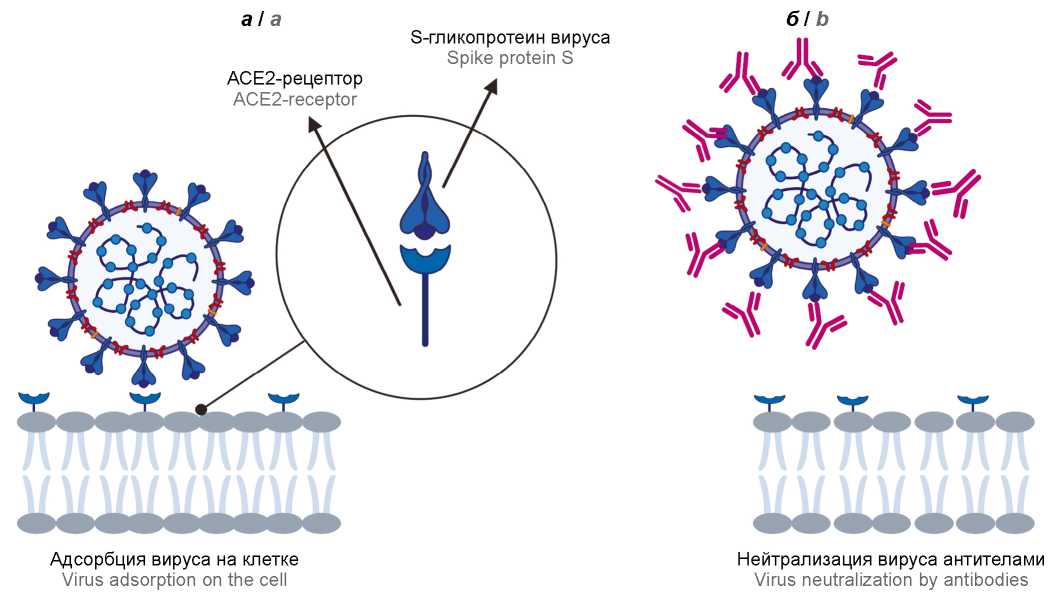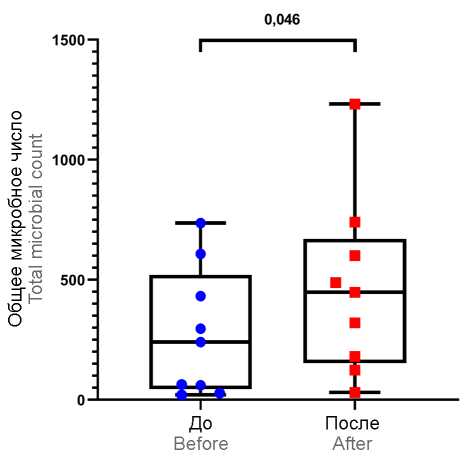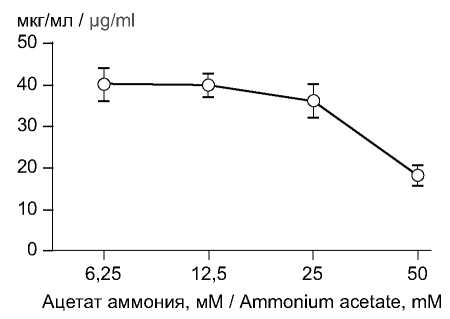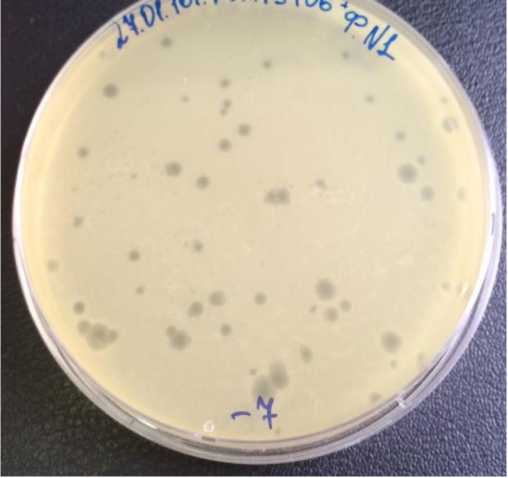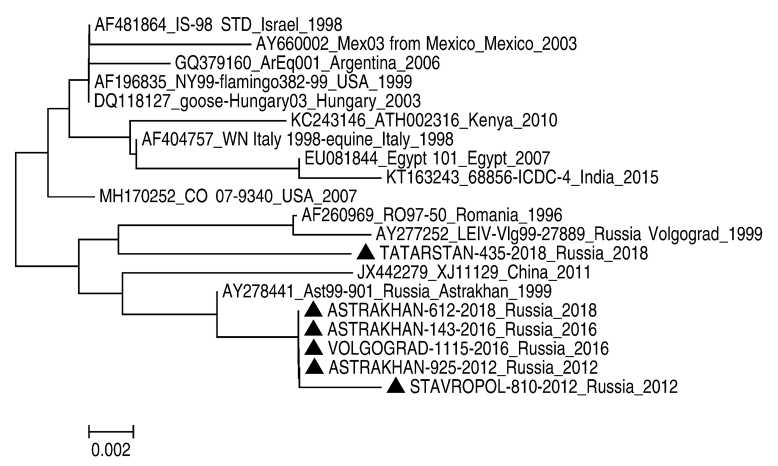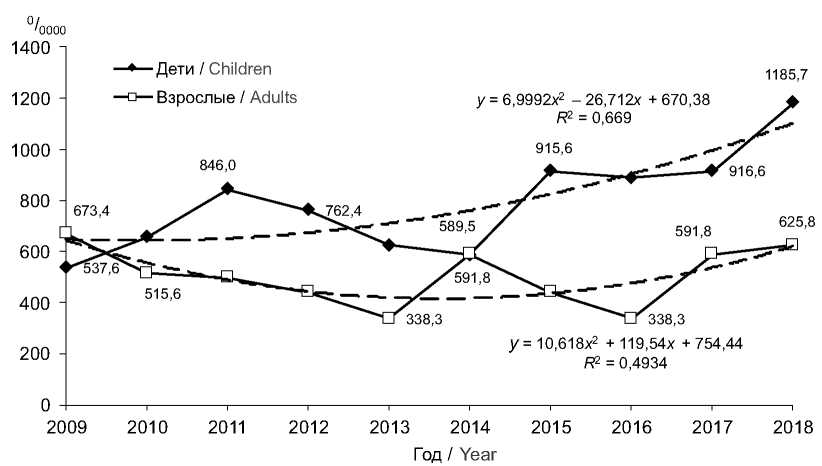Том 98, № 3 (2021)
- Год: 2021
- Дата публикации: 03.07.2021
- Статей: 14
- URL: https://microbiol.crie.ru/jour/issue/view/44
Весь выпуск
ОРИГИНАЛЬНЫЕ ИССЛЕДОВАНИЯ
Адаптация МТТ-теста для определения нейтрализующих антител к вирусу SARS-CoV-2
Аннотация
Введение. Основным показателем специфической активности антител к вирусу SARS-CoV-2 является их способность нейтрализовать вирус. Тест на вируснейтрализующие антитела (ВНА) широко востребован в различных направлениях биомедицинских исследований.
Целью работы являлся подбор оптимальных условий для определения ВНА к вирусу SARS-CoV-2 по ингибированию цитопатогенного действия (ЦПД) в культуре клеток с возможностью как микроскопического, так и спектрофотометрического учёта результата.
Материалы и методы. Сыворотку крови реконвалесцентов COVID-19 и здоровых лиц (n = 96) изучали методом ИФА. Коронавирус SARS-CoV-2, штамм Dubrovka (номер GenBank: MW514307.1) выращивали в культуре клеток Vero CCL81 (ATСС). Идентификацию вируса проводили методами ОТ-ПЦР-РВ, ИФА и секвенирования по Сэнгеру. Результаты реакции нейтрализации (РН) учитывали по ЦПД микроскопически и в метилтетразолиевом (МТТ) тесте.
Результаты. От больного COVID-19 изолирован коронавирус SARS-CoV-2 и адаптирован к выращиванию в культуре клеток. При заражении низкой дозой (MOI = 0,00001) вирус вызывал выраженное ЦПД с выживаемостью клеток менее 3%, что позволяло учитывать результаты РН по ингибированию ЦПД. Сравни- тельный анализ сывороток в РН и методом ИФА показал достоверную корреляцию между титрами ВНА и титрами антител к RBD-домену S-белка (Спирмен r = 0,714; р < 0,001). Результаты определения ВНА с микроскопической и спектрофотометрической детекцией (тест МТТ) также достоверно коррелировали (Спирмен r = 0,963; р < 0,05).
Заключение. На основе адаптированного к культуре клеток Vero вируса SARS-CoV-2 разработана система оценки титра ВНА, позволяющая учитывать результат как с помощью микроскопического исследования, так и спектрофотометрически в МТТ-тесте. Применение теста МТТ позволяет автоматизировать учёт результатов РН, проводить статистическую обработку получаемых данных, снижает субъективизм при оценке результата. Являясь витальным красителем, МТТ выявляет только живые клетки, что повышает надёжность получаемых результатов по сравнению с другими красителями.
 253-265
253-265


Дополнительный резервуар госпитальных микроорганизмов в медицинских организациях
Аннотация
Введение. Подавляющее большинство инфекций, связанных с оказанием медицинской помощи (ИСМП), развиваются в результате колонизации локусов пациентов госпитальными штаммами возбудителей.
Цель исследования — изучение дополнительного резервуара микроорганизмов в медицинских организациях.
Материалы и методы. Исследовано 28 образцов больничной пыли методами сканирующей электронной микроскопии и динамического рассеяния света, энергодисперсионной рентгеновской спектроскопии и высокотемпературного каталитического окисления, 97 проб — полимеразной цепной реакцией и на бактериологическом анализаторе «VITEK®2 Compact» с целью исследования микробного разнообразия. Проведены индикация биологических плёнок (n = 29) с помощью каталазного индикатора, определение общего количества микроорганизмов в 1 м3 воздуха.
Результаты. Пыль вентиляционных решеток контаминирована в 71,13% случаев, доля резистентных к антибиотикам штаммов бактерий — в 69,44%, бактерий, образующих биопленки, — в 48%. Биоразнообразие представлено 21 родом микроорганизмов, сохранявшимся в течение 6 мес. Во всех образцах присутствовала наноразмерная фракция. Органический субстрат представлен углеродом (16,26–50,69%), азотом (1,59–25,03%), водородом (2,03–6,67%), серой (0,15–2,38%) и кислородом (20,02–37,50%). Общее микробное число до и после открывания дверей и окон — 276 и 462 КОЕ/м3 соответственно (p = 0,046). Минеральный компонент содержал натрий (0,07–1,86%), магний (0,11–1,40%), алюминий (0,36–1,78%), кремний (0,21–4,64%), фосфор (0,04–0,81%), хлор (0,05–2,83%), калий (0,04–0,85%), кальций (0,19–7,49%), железо (0,08–1,61%).
Обсуждение. Широкий спектр микроорганизмов, наличие органического субстрата и микроэлементов свидетельствуют о возможности сохранения, накопления и возврата в больничную среду возбудителей ИСМП.
Заключение. На решетках вытяжных вентиляционных систем и прилежащих частей воздуховодов в условиях медицинских организаций может формироваться дополнительный резервуар микроорганизмов — возбудителей ИСМП, играющий значимую роль в поддержании эпидемического процесса ИСМП.
 266-275
266-275


Механизм персистенции индигенных бифидобактерий под действием ацетата в кишечном биотопе человека
Аннотация
Цель исследования — определить роль ацетата в персистенции индигенных бифидобактерий в кишечном биотопе через лизоцимрезистентность в модельных условиях ацетилирования–деацетилирования пептидогликана.
Материалы и методы. Исследовано по 16 штаммов двух видов индигенных бифидобактерий: Bifidobacterium bifidum и Bifidobacterium longum subsp. longum. Бифидобактерии культивировали в СO2-инкубаторе при cодержании O2 0,6%, CO2 9% и температуре 37ºС в течение 48 ч. Продукцию уксусной кислоты (ацетата) бифидобактериями выявляли методом газовой хроматографии. Влияние ацетата на устойчивость неиндигенных грамположительных бактерий к лизоциму определяли на модели штамма Listeria monoytogenes ICIS-280 путём культивирования в бульоне LB-Lennox с добавлением ацетата аммония в диапазоне концентраций, продуцируемых исследуемыми бифидобактериями, в серии разведений лизоцима в конечных концентрациях от 5 до 40 мкг/мл в течение 24 ч.
Результаты. Установлено, что у Bifidobacterium longum subsp. longum выделение ацетата в среднем было в 2 раза выше, чем у Bifidobacterium bifidum (14,7 и 27 ммоль/л соответственно), и вполне соответствовало концентрациям уксусной кислоты, определённым в кишечном содержимом (до 50 ммоль/л). Культивирование бифидобактерий в среде с лизоцимом, ацетатом аммония и их сочетанием не оказало существенного влияния на их показатели роста при максимальных использованных концентрациях данных веществ. У тест-штамма добавление ацетата аммония в диапазоне, создаваемом бифидобактериями, вызывало снижение минимальной подавляющей концентрации лизоцима более чем в 2 раза — от 40 до менее 20 мкг/мл. В контрольной среде без лизоцима не отмечено ингибирования роста индикаторной культуры вплоть до максимальных концентраций ацетата аммония.
Заключение. Выявлен механизм персистенции (выживания) индигенных бифидобактерий в кишечном биотопе человека путём продукции ацетата, избирательно подавляющего лизоцимрезистентность неиндигенных грамположительных бактерий, за счёт обратимости деацетилирования пептидогликана, что позволяет индигенным бифидобактериям сохранять стабильное доминантное положение в биотопе.
 276-282
276-282


Влияние антител к агглютиногенам 1 и 2, филаментозному гемагглютинину и коклюшному токсину на формирование биоплёнок Bordetella pertussis на абиотическом субстрате
Аннотация
Цель. Изучение влияния антител к агглютиногенам (АГ) -1 и -2, филаментозному гемагглютинину (ФГА) и коклюшному токсину (КТ) на формирование биоплёнок штаммами Bordetella pertussis на абиотическом субстрате.
Материалы и методы. Использованы вакцинные и свежевыделенные штаммы B. pertussis. В качестве инокулята для получения биоплёнок использовали культуры штаммов, выращенных на плотной питательной среде. Интенсивность образования биоплёнок в присутствии сывороток к АГ-1 и -2, ФГА и моноклональных антител (МКА) к S1-, S2- и S3-субъединицам КТ в круглодонных полистироловых 96-луночных планшетах оценивали окрашиванием 0,1% раствором генцианового фиолетового.
Результаты. Большинство исследованных штаммов были чувствительны к антителам, что проявлялось в полном подавлении образования биоплёнок. Все штаммы были чувствительны к сыворотке к АГ-1, сыворотке к ФГА, МКА к S2-субъединице КТ. К сыворотке к АГ-2 были чувствительны 3 из 4 исследованных штаммов, имеющих этот АГ в своем составе: № 475 (серовар 1.2.3), № 317 (серовар 1.2.3) и № 178 (серовар 1.2.0). Относительная устойчивость к сыворотке была выявлена только у штамма № 305 серовара 1.2.0, однако при минимальном её разведении интенсивность образования биоплёнки была в 1,8 раза ниже, чем в контроле. Штаммы № 703 (серовар 1.0.3) и № 287 (серовар 1.0.3), не имеющие АГ-2, были устойчивы к сыворотке. К МКА к S1- и S3-субъединицам КТ были чувствительны, соответственно, 4 и 5 из 6 использованных штаммов. Штамм № 305 был устойчив к МКА к S1- и S3-субъединицам, а штамм № 287 — к МКА к S1-субъединице. При этом при минимальном разведении МКА интенсивность образования биоплёнок была, соответственно, в 2 и 1,8 раза ниже, чем в контроле.
Заключение. Приведённые данные свидетельствуют о подавлении роста биоплёнок штаммов B. pertussis антителами как к поверхностным структурам микробной клетки (АГ-1 и -2, ФГА), так и к S1-, S2- и S3-субъ- единицам КТ.
 283-289
283-289


Биологические свойства и генетическая характеристика экспериментальных диагностических бактериофагов Vibrio cholerae
Аннотация
Актуальность. В настоящее время проводится работа по конструированию новых диагностических и профилактических препаратов на основе бактериофагов, поэтому актуально изучение биологических свойств холерных фагов наравне с их генетической структурой. Эта информация необходима для прогнозирования жизненного цикла фага и оценки перспектив практического использования в экспериментальной деятельности, фагодиагностике или фагопрофилактике.
Материалы и методы. Наличие или отсутствие генов, характерных для умеренных бактериофагов, проверяли при помощи созданной авторами базы данных и программного обеспечения «PhageAnalyzer», позволяющего проводить быстрый анализ данных полногеномного секвенирования бактериофагов и прогнозировать их жизненный цикл.
Результаты и обсуждение. Морфологическая структура экспериментальных диагностических холерных фагов представлена головчатыми бактериофагами различных морфогрупп. Негативные колонии фагов различались по диаметру, форме и степени прозрачности. В геномах бактериофагов Rostov-1, Rostov-6, Rostov 7 и Rostov M3 генетических детерминант факторов резистентности и токсинов не обнаружено. В результате филогенетического анализа определено, что исследованные холерные экспериментальные бактериофаги имеют сходство с головчатыми фагами из рода Vibrio, но являются уникальными, т.к. находятся «вне кластерных групп». Vibrio фаги Rostov-1 и Rostov M3 являются литическими. У холерных фагов Rostov-6 и Rostov 7 найдены гены, характерные для умеренных бактериофагов.
Заключение. Экспериментальный холерный бактериофаг Rostov-1 может быть использован для дифференциации холерного вибриона О1 серогруппы биовара El Tor, а Vibrio фаг Rostov M3 — для биовара Classical. Оба бактериофага являются литическими и перспективными компонентами для создания профилактических препаратов против холеры. Vibrio фаги Rostov-6 и Rostov 7 могут быть успешно использованы только в экспериментальной деятельности, а также при мониторинге холерных вибрионов из окружающей среды. Полные геномные последовательности зарегистрированы и доступны в международной базе GenBank (NCBI).
 290–297
290–297


Оценка действия азоксимера бромида (полиоксидония) на адгезивные свойства вакцинного штамма Yersinia pestis EV НИИЭГ по данным атомно-силовой микроскопии
Аннотация
Цель. Изучить характер действия азоксимера бромида (полиоксидония, ПО) в условиях культивирования на морфометрические показатели и адгезивность вакцинного штамма Yersinia pestis EV НИИЭГ и его изогенных производных Y. pestis КМ218 (pYT–, pYV–, pYP–), Y. pestis КМ216 (pYT–, pYV–, pYP+), Y. pseudotuberculosis, Y. enterocolitica с применением атомно-силовой микроскопии (АСМ), а также на адгезию клеток Y. pestis EV НИИЭГ к коллагену человека IV типа.
Материалы и методы. Измерения осуществляли с помощью сканирующего зондового микроскопа с использованием стандартных методов полуконтактной АСМ и программы анализа АСМ-изображений. Адгезию Y. pestis EV НИИЭГ к коллагену человека IV типа человека определяли по количеству клеток, прикрепившихся к стеклянным слайдам с коллагеном IV типа.
Результаты. Внесение ПО в среду культивирования вызывало достоверные изменения морфометрических параметров клеток Y. pestis EV НИИЭГ и его изогенных производных (увеличение объема, коэффициента уплощённости, индекса I), указывающих на повышение пластичности и снижение ригидности клеточной стенки. Данные изменения сопровождались трансформацией наномеханических свойств клеточной поверхности (снижением среднеквадратической шероховатости, силы адгезии), выраженность которых связана с плазмидным профилем. В меньшей степени понижение силы адгезии при отсутствии достоверных изменений индекса I наблюдалось у клеток Y. pseudotuberculosis I и IV сероваров, а также у бактерий Y. enterocolitica 09 серовара c плазмидой pYV+. У штамма Y. enterocolitica КМ383 (рYV−) ПО не индуцировал значимых изменений изучаемых показателей. Внесение ПО в среду культивирования приводило также к снижению способности клеток Y. pestis EV НИИЭГ прикрепляться к коллагену человека IV типа. Модификация ПО адгезивных свойств вакцинного штамма Y. pestis EV НИИЭГ сопровождалась повышением его иммуногенности.
 298-307
298-307


Молекулярно-генетический анализ вариантов вируса Западного Нила, циркулировавших на территории европейской части России в 2010–2019 гг.
Аннотация
Цель. Изучение распространённости генотипов и геновариантов вируса Западного Нила (ВЗН) на территории юга России в 2010–2019 гг.
Материалы и методы. Для исследования использовали 311 инфицированных ВЗН образцов биологического материала от больных, переносчиков и резервуаров инфекции. Типирование ВЗН проводили посредством сконструированных 3 пар праймеров и 3 зондов методом полимеразной цепной реакции с обратной транскрипцией в реальном времени и секвенированием участка генома ВЗН размером 277 п.н., соответствующего 5'-нетранслируемой области и локусу гена полипротеина, кодирующему капсидный белок. Анализ результатов секвенирования проводили с помощью программы «Nucleotide BLAST» (NCBI).
Результаты. Из 311 РНК-изолятов ВЗН 15 (4,82%) были отнесены к генотипу 1 (из Астраханской и Волгоградской областей, Краснодарского и Ставропольского краев, Республики Татарстан), 285 (91,64%) — к генотипу 2 (из Астраханской, Волгоградской, Воронежской, Курской, Липецкой, Пензенской, Ростовской и Саратовской областей, Краснодарского и Ставропольского краёв, республик Калмыкия и Крым) и 11 (3,54%) — к генотипу 4 (из Волгоградской области, республик Калмыкия и Крым). Отмечено выраженное преобладание по частоте встречаемости вируса генотипа 2. Установлено, что выявленные изоляты возбудителя генотипа 1 относятся к астраханскому геноварианту, генотипа 2 — к российскому и европейскому геновариантам. Обнаружены ранее не встречавшиеся варианты ВЗН генотипов 1 и 4.
Заключение. В последнее десятилетие ВЗН генотипа 2 является доминирующим для юга европейской части России. Наиболее распространён российский вариант, его ареал расширяется. Циркуляция различных генетических линий ВЗН на территории России свидетельствует о необходимости дальнейшего изучения их распространения, а также совершенствования диагностических методов и тест-систем для выявления и дифференциации штаммов возбудителя.
 308-318
308-318


НАУКА И ПРАКТИКА
Разработка и практическое применение методики для идентификации поверхностных антигенов Borrelia miyamotoi
Аннотация
Введение. Borrelia miyamotoi — возбудитель безэритемной формы иксодового клещевого боррелиоза (ИКБ) — заболевания, широко распространённого в России. В геноме B. miyamotoi присутствуют гены десятков вариабельных основных поверхностных белков (Vmp). Vmp разделяют на два семейства — Vsp и Vlp (с подсемействами δ, γ, α и β). В конкретный момент времени отдельная B. miyamotoi экспрессирует единственный вариант гена Vmp.
Цель работы — создание методики для идентификации гена Vmp, находящегося в сайте экспрессии.
Материалы и методы. Методика реализована в формате мультиплексной ПЦР в режиме реального времени. Для её испытания были использованы образцы ДНК B. miyamotoi, выделенные из крови 172 больных ИКБ и 109 клещей. Образцы были собраны в 14 регионах России.
Результаты. Разработанная методика позволила идентифицировать экспрессирующийся Vmp в 82% исследованных проб, т.е. показала достаточную эффективность. Отрицательные результаты значимо реже наблюдались среди проб от больных, чем среди проб клещей. При этом доля проб с Vmp только одного типа одинакова среди клинических образцов и клещей, а доля проб, в которых детектируются одновременно два типа Vmp, значимо выше среди образцов от больных, где наиболее часто встречалась комбинация Vlp-δ и Vsp.
Обсуждение. Тот факт, что в образцах крови чаще выявляется сочетание двух типов Vmp, может говорить об одновременном присутствии нескольких субпопуляций B. miyamotoi в организме больных ИКБ. После того как к основному поверхностному белку штамма, занесённого клещом, вырабатываются протективные антитела, происходит переключение на синтез нового антигенного варианта Vmp. Такой феномен, называемый «иммунным избеганием», позволяет патогену персистировать в организме хозяина.
Заключение. Созданная методика мультиплексной ПЦР в режиме реального времени позволяет проводить одновременную детекцию нескольких антигенных вариантов вариабельных основных поверхностных белков B. miyamotoi. Изучение антигенного спектра штаммов B. miyamotoi в сопоставлении с характеристикой консервативных участков генома методом мультилокусного секвенирования позволит прояснить этапы эволюции и распространения B. miyamotoi sensu lato.
 339-350
339-350


Распространённость туберкулеза у детей, перинатально экспонированных ВИЧ и ВИЧ-инфицированных, и предикторы его развития
Аннотация
Цель исследования — установить факторы риска заболевания туберкулёзом (ТБ) детей, перинатально экспонированных ВИЧ и ВИЧ-инфицированных, для разработки коррекционных мероприятий.
Материалы и методы. Проанализированы амбулаторные карты (форма № 025/у) 216 детей, перинатально экспонированных ВИЧ, и 121 ребенка с ВИЧ-инфекцией и их родителей (281 человек). Контрольную группу составили 100 здоровых детей. В работе использованы эпидемиологический (описательно-оценочный и аналитический) и статистический методы исследования.
Результаты. Вероятность контакта с больным активной формой ТБ у детей, перинатально экспонированных ВИЧ и ВИЧ-инфицированных, была достоверно выше относительно детей контрольной группы (p < 0,001). Риски заболевания ТБ у детей, экспонированных ВИЧ, в очагах, где оба родителя были ВИЧ-инфицированными, в 5,3 раза превышали таковые в очагах, сформированных дискордантными парами (RR = 5,3; 95% ДИ 1,7–21,7). Дети исследуемых групп, не вакцинированные БЦЖ, подвержены наибольшему риску заболевания ТБ по сравнению с детьми контрольной группы (RR = 1,9; 95% ДИ 1,6–2,2).
Заключение. Факторами риска заболевания ТБ у детей, перинатально экспонированных ВИЧ, являются несвоевременная вакцинация против ТБ или ее отсутствие и проживание в очаге, где оба родителя были ВИЧ-инфицированными. Предикторами развития ТБ у ВИЧ-инфицированных детей был контакт с больными ТБ в семье, поздняя диагностика ВИЧ-инфекции и назначение высокоактивной антиретровирусной терапии позже 6 мес после постановки диагноза на фоне сформировавшейся иммуносупрессии.
 351-361
351-361


ОБЗОРЫ
Систематический обзор вспышек гемоконтактных инфекций (гепатит В, С, ВИЧ), передающихся от пациента к пациенту при оказании медицинской помощи
Аннотация
Медицинские учреждения всегда имели значение в передаче гемоконтактных инфекций. Манипуляции, сопровождающиеся образованием крови, представляют опасность в распространении гепатитов В, С и ВИЧ не только для персонала, но и для пациентов. С целью оценки значения медицинских учреждений в передаче гемоконтактных инфекций, выявления групп риска среди пациентов и факторов передачи проанализировано 75 вспышек гепатита В, С и ВИЧ, данные о которых опубликованы в разных странах в 2008–2020 гг. Проведено сравнение вспышек в США в течение 1992–2008 и 2008–2019 гг. Основной причиной вспышек гемоконтактных инфекций в медицинских учреждениях является несоблюдение медицинским персоналом стандартных профилактических мер: повторное использование изделий однократного применения; отсутствие обработки рук; повторное применение перчаток; отсутствие дезинфекции поверхностей, многоразовых приборов и устройств; отсутствие стерилизации многоразовых инструментов. К учреждениям высокого риска в отношении заражения гемоконтактными инфекциями от- носятся учреждения, проводящие гемодиализ, онкогематологические, амбулаторные учреждения, дома престарелых, интернаты, клиники, где проходят лечение пациенты с сахарным диабетом. Контингентом высокого риска являются пациенты, получающие гемодиализ, онкогематологические пациенты и пациенты с сахарным диабетом. Диагностика гемоконтактных инфекций на регулярной основе, вакцинация против гепатита В среди пациентов высокого риска, расследование вспышек, внедрение регламентов работы в сочетании с обучением и контролем приверженности персонала являются решением проблемы нозокомиальной передачи гемоконтактных инфекций.
 319-330
319-330


Нарушения кишечной микробиоты при расстройствах аутистического спектра: новые горизонты в поиске патогенетических подходов к терапии. Часть 3. Потенциальные стратегии влияния на ось кишечник–мозг для коррекции симптомов расстройств аутистического спектра
Аннотация
Третья часть обзора литературы, посвящённого роли нарушений кишечной микробиоты в патогенезе расстройств аутистического спектра (РАС), содержит анализ опубликованной литературы о возможных интервенционных подходах в отношении кишечной микробиоты при РАС и оценку эффективности различных типов вмешательств, которые изучались в эксперименте и клинической практике. Приведены имеющиеся к настоящему времени данные о возможности коррекции кишечной микробиоты при РАС с помощью диеты, приёма пре- и пробиотиков, антибиотикотерапии, а также об эффективности трансплантации кишечной микробиоты. Анализ опубликованных данных свидетельствует о том, что дальнейшая разработка подходов к коррекции дисбиоза кишечника при РАС может дать безопасные и, вероятно, эффективные в отношении поведенческих симптомов подходы, но это требует дальнейших рандомизированных контролируемых исследований для подтверждения эффективности и безопасности с позиции доказательной медицины, поскольку имеющиеся к настоящему времени исследования являются малочисленными и раз- розненными, в связи с чем их можно считать предварительными.
 331-338
331-338


НЕКРОЛОГИ
 362-363
362-363


 364
364


ЮБИЛЕИ
 365-366
365-366










